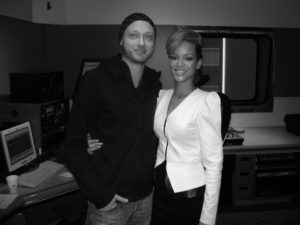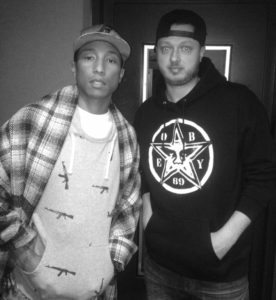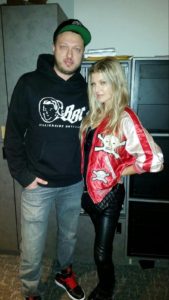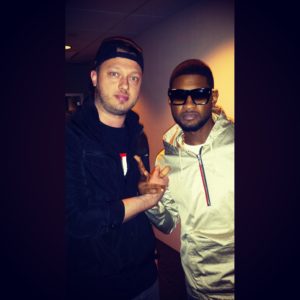I met Dom Nero a few years ago and was blown away from his work on HOT 97! After chatting via email a few times I found out that Dom had a spectacular journey and is originally from Canada. Seriously, Canada has a great Imaging scene and tradition with guys like John Masecar, Andy McBeth, Chris Pottage, David Tyler and Gary McClenaghan, for example. So, learn from one of the best. Check out what celebrities are hanging out in his studio, and enjoy his screen caps!
Enter Dom!
 AS: Which production system do you use and why?
AS: Which production system do you use and why?
DN: First off, let me say I’m not one of those guys who believes one DAW is better than another. I never get into that debate. I believe people should try multiple DAWs and see what feels most comfortable to them. There’s no option in any DAW that says “produce me a kick-ass piece of production” (at least that I’m not aware of). That being said, I’m a ProTools guy. When I got into the whole production thing in the early 2000’s, I worked with quite a few programs (and I still like to try new DAWs today). The reason (or my mentality) for learning Pro Tools was this…Pro Tools was billed as the “industry standard” and was being used in most studios. I figured if I walked into a studio, chances were they would be working on PT, and I wanted to be able to sit down and get right to work. It may be somewhat different nowadays, but PT is still the DAW that makes most sense to me in terms of layout and navigation.
AS: What are your favourite Plug-ins?
DN: Even though I have a lot of plugins, it’s funny…I only have a few I would call go-to plugins. Waves plugins I feel are a good “must”. Other than that, I find myself using BX plugins (EQ specifically), Sonnox plugins, and as of late….UAD plugins. I find the UAD plugins (especially the SSL series) to be great! Again, as with DAWs, I think one can achieve some really great stuff with any plugins…even free ones!!

AS: How do you schedule your work (priorities)?
DN: At HOT 97, there’s no real method or regimented routine I follow. Basically, what’s needed the soonest and what will play the most is what I tackle first. In an ideal world, an imaging person would have a few days notice on everything needed. Unfortunately (or fortunately, if you like the challenge), I don’t live in a perfect radio world. Major station promotions come down last minute sometimes and are needed asap. Something happens and promotions get changed the day they’re supposed to hit the air. If it’s a rare non-crazy day, I usually start with cutting some morning show promos/imaging and then work my way to general station imaging and promos. Pretty simple really. When it comes to my freelance work, I do have a little more of a routine: A few hours 2-3 nights a week and some hours over the weekend. I love working at night so I generally get most freelance done late night on the weekend.

AS: What do you love about working at HOT 97?
DN: I would have to say first and foremost, the people. Everyone there really cares about the brand and it shows. Working for such an influential station, which has given so much to the hip hop culture, is something a lot of people dream of and I think everyone working there realizes it’s (HOT 97’s) importance in hip hop and radio in general.
I also love the fact that no two days are alike. There’s always something happening or artists passing through. Whether it be debuting a new Kanye West record first or an interview by our morning show that will make waves online.
AS: What is the best Pro Tools or production trick anybody should know?
DN: Hmmm….tough one. The best trick (or tip I should say), is watching levels. It’s no secret, but you’d be surprised how many sessions I see where all the tracks are clipping, plugins are being fed levels that are way too hot, and busses have constant levels in the red.
Another tip that helps me work quickly (and happily) is file management. I wasn’t always so organized in my early production days and I hated when I couldn’t find something. It was so frustrating!!! Now, everything I do (whether it be a final produced piece or a raw artist liner I just recorded) is clearly/descriptively labeled and filed.
AS: How do you get inspired and what do you use as a source of creativity?
DN: I get inspired by not spending all my time in the studio!!! Getting out, going to clubs, other studios, the movies, producing music, or listening to production from others around the world all inspire me. I enjoy watching interviews online with music producers, engineers, musicians, etc. I guess I’m kind of lucky because living in NYC there’s so much going on all the time. The city itself is an inspiration.

AS: Who were your radio production idols? Who influenced your work as a producer?
DN: Pre-internet days, growing up in Toronto, I really enjoyed listening to the production of a local radio station called Z103.5 (which at the time was called HOT 103). I believe the gentleman’s name that imaged the station at that time was Guy Charbinau. Then, when I was able to get my hands on imaging from stations in the United States, I started to look up to guys like Dave Foxx, Eric Chase, and Jeff Thomas. I would say those three gentlemen, along with my college radio professor in Toronto, Jim Carr, really had an impact on me pursuing a career in radio imaging.
 AS: What would be your three key pieces of advice for a youngster?
AS: What would be your three key pieces of advice for a youngster?
DN:
1. Patience! I find that many young people today get discouraged pretty fast if they’re not presented with a job opportunity immediately. You have to be patient no matter what career you’re pursuing. There were many times I wanted to give up, but the thought of not doing what I loved simply outweighed quitting.
2. Practice! Again, no matter the craft, ”practice makes perfect” (or will put you on that path). I would sit in my room and produce promos for…are you ready for this…(dramatic pause)…NO ONE! While my friends were going out, I would sit in my room with headphones on (or take the bus to the college I attended to use their facilities before I could afford a computer and DAW) and just produce stuff. I’m glad I did. I feel like those hours of practice paid off.
3. Learn to play an instrument or learn to DJ! Being a nightclub DJ really helped me when I got into radio imaging. Knowing about time signature, what a down beat is and all of that good stuff really helped me when cutting audio in production. It actually became second nature. Even though as radio production people we’re not “making music”, the best imaging in my opinion still follows some rhythmic flow.

AS: Imaging in NYC, what do you guys do different? Why are there so many great imaging guys?
DN: You know, I’ve never really given that much thought to tell you the truth. I’m guessing it has to do with the city itself and it’s makeup. It’s a very progressive/forward-thinking city and I think that’s reflected in many ways. I think stations here are not afraid to take chances. This is where a lot of music is played on the radio first and new ways of doing things are embraced. A few years after I was hired at HOT 97, I asked my PD why he hired me. His answer was simply “because you’re not from New York and you don’t come from a hip hop imaging background.” His mentality was that it was time for a change. He told me “approach HOT 97 like you did in the past when you worked for CHR stations and Rock stations.” In hindsight I think that was pretty ballsy, but I guess those are the chances one takes to be better and different. That being said, I’m sure there are people all over the world who are talented and creative enough to hold down a gig in any of the top markets here. I’ve always loved the imaging coming out of the UK and Europe, as well as Australia and Canada.
If you want to contact Dom or just want to be up to date, check out his Twitter and Instagram: @IAmDomDaBomb
Thanks for this great interview, Dom!
Subscribe Now – Free!
Broadcast Dialogue has been required reading in the Canadian broadcast media for 25 years. When you subscribe, you join a community of connected professionals from media and broadcast related sectors from across the country.
The Weekly Briefing from Broadcast Dialogue is delivered exclusively to subscribers by email every Thursday. It’s your link to critical industry news, timely people moves, and excellent career advancement opportunities.
Let’s get started right now.



